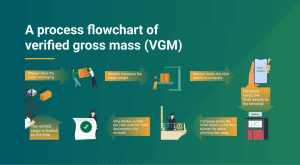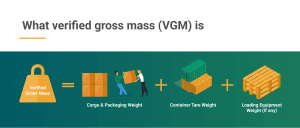What is VGM?
VGM stands for Verified Gross Mass, which refers to the verified total weight of a container. The International Maritime Organization (IMO) announced the implementation of amendments to the Safety of Life at Sea (SOLAS) Convention regarding the verification of container weights. As of July 1, 2016, containers cannot be loaded onto ships unless the shipper provides the verified container weight to the carrier and/or terminal representative.
Key points of the new regulation include:
- Shippers are responsible for providing the container’s verified gross mass.
- Two approved methods are available to determine the container weight.
- Terminal operators must ensure that only containers with verified weights are loaded onto vessels.
This regulation, commonly referred to as the container weighing rule, is a critical measure designed to enhance maritime safety. By ensuring the accuracy of container weights, the rule reduces risks associated with container transport, safeguarding goods, equipment, and personnel across the supply chain.
I. Why is VGM Mandatory?
The requirement for VGM aims to mitigate the risks posed by misreported container weights, which can endanger personnel, goods, and equipment both onshore and at sea. Such risks have been linked to accidents, underscoring the necessity of this regulation to improve safety standards.
II. Allowable VGM Error Margins

The difference between the declared weight and the actual weight must not exceed 5% or 1 ton, whichever is smaller.
The two approved methods for calculating VGM are:
- Weighing the fully packed container:
This involves using specialized equipment to directly weigh the container after loading. - Adding individual weights:
Shippers can weigh all cargo, items, and packaging materials within the container and add the tare weight (empty weight) of the container.
For example, if an empty container’s tare weight is 4 tons and the total cargo weight is 22 tons, the VGM would be 4 + 22 = 26 tons.
III. Who Submits VGM Data?

The shipper is responsible for providing the actual container weight to the booking agent (freight forwarder). The forwarder, in turn, submits the data to the carrier or its agent electronically (via EDI), and the carrier provides the VGM to the terminal.
Note: Carriers do not verify the accuracy of the VGM. They rely on shippers to provide accurate data.
IV. Risks of Not Submitting Accurate VGM
- Refusal to Load:
If VGM is not submitted or if the data significantly deviates from the actual weight, the carrier may refuse to load the container onto the vessel. - Return of Goods:
Containers may be returned to the origin, incurring additional costs such as loading/unloading fees and transportation expenses. - High Penalties:
Carriers or regulatory authorities may impose hefty fines for non-compliance. - Transshipment Issues:
At transshipment ports, discrepancies in VGM data may require cargo to be offloaded, weighed, or adjusted, leading to extra operational costs and delays. - Customs Inspection:
Inaccurate VGM data may trigger customs inspections, delaying clearance and potentially leading to further complications if discrepancies are found.
V. VGM Submission Deadlines
Each carrier sets its own deadline for VGM submission. Generally:
- Modifications to VGM are free before the deadline.
- Changes after the deadline may incur fees.
- As a rule, changes are not accepted within 6 hours of the vessel’s scheduled departure, unless otherwise specified by the carrier.
VI. Background Information
In May 2014, the IMO’s Maritime Safety Committee approved amendments to the SOLAS Convention, making container weight verification mandatory. These amendments were adopted in November 2014 and became legally binding on July 1, 2016.
Key Responsibilities under SOLAS Amendments:
- Shippers must provide an accurate Verified Gross Mass (VGM).
- Vessel and terminal operators must ensure that containers without VGM are not loaded onto vessels.
Methods for Determining VGM:
- Method 1:
The shipper may weigh the packed container using certified equipment. - Method 2:
The shipper (or a third party) may weigh all cargo, packaging materials, and dunnage within the container, and add the container’s tare weight.
By adhering to these guidelines, the VGM requirement significantly improves maritime safety and reduces risks associated with misdeclared container weights.


